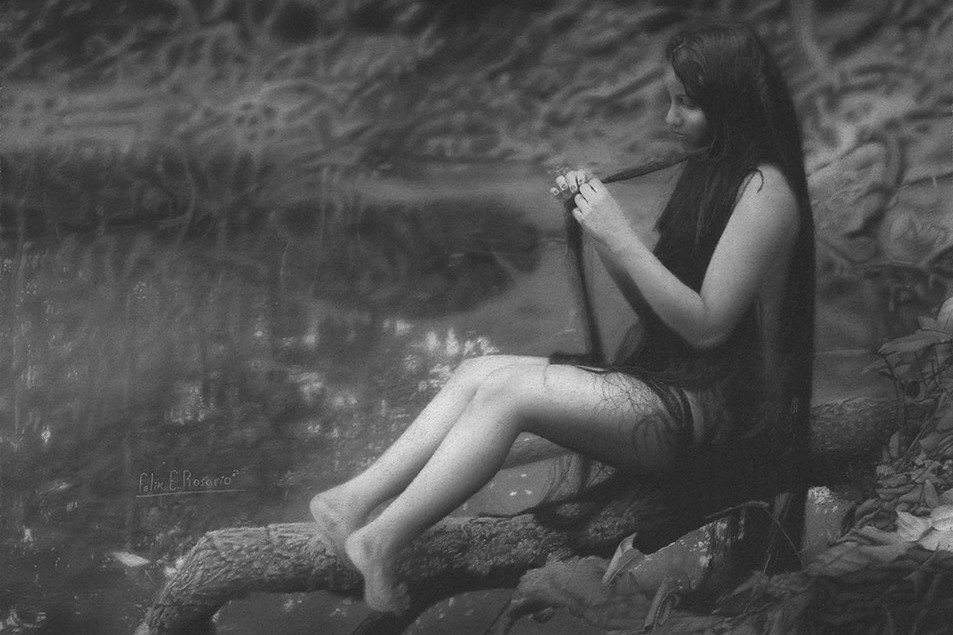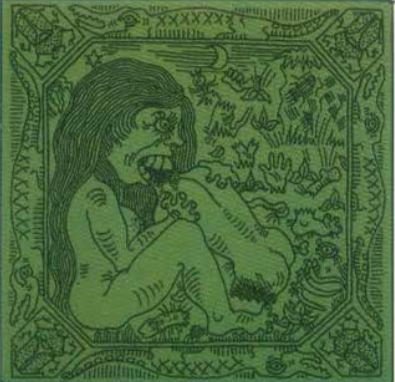The Curse of La Ciguapa of The Dominican Republic
Sometimes referred to as the most well-known legend or creature in the Dominican Republic, the terrifying Ciguapa is often described as a demonic beautiful woman with backward-facing feet that hunts in the forests. But what are the other more tragic versions of this legend and where did it come from?
Ciguapa by Felix Esteban Rosario. Pastels on paper.
The Deadly Cinguapa
Along the mountainous ranges and lurking in the shadows throughout the forests of the Dominican Republic, there is a creature that appears as a beautiful woman to some. Appearing only at night she’ll lure her victims, usually men, with the chirps of a bird or the sounds of a soft moan.
Any who follow the sounds will find the dark-skinned woman standing naked with alluring eyes and hair described as soft and lustrous, falling down to her ankles. When the men approach they’ll notice her eyes are completely black as if demonic but by then it’s too late, the men fall into a trance and follow the Ciguapa.
The Ciguapa will take the men to an isolated place where she’ll finally attack them, draining them of their blood with a kiss or killing them and eating their bodies over a period of weeks.
Those that go out looking for the lost men will be left confused as the Ciguapa’s most defining feature is her backward-facing feet. The tracks she leaves will send the searchers in the opposite direction ensuring she’s never found.
Other Versions of La Ciguapa
There are plenty of other versions of the Ciguapa, some sharing the same characteristics as above and adding more violent tendencies. In some versions, the Ciguapa will lead the men to her cave where she makes love to them first before killing and eating them. Other versions say she’ll lift the men up the trees where she spends most of her time and kill them there, returning to the tree to eat their flesh whenever she’s hungry.
But, the most common variation is a much more peaceful Ciguapa, that doesn’t hunt men until necessary. These stories tell of a Ciguapa who is incredibly shy, prefers to eat small animals and fruit, but will break into homes on the eve of a full moon to steal meals.
If the Ciguapa is caught or if someone stumbles upon her while she is out in the forest, they fall into her trance and she’ll choose to kill and eat them.
Those that hunt for the Ciguapa must do so on the eve of a full moon or during a full moon (depending on the legend) and must do so with a polydactyl dog that has six toes. These are the only types of dogs that can pick up her scent and track her down. If the hunters find the Ciguapa and are able to capture her, her sadness and distress will kill her in three days.
While this version of the Ciguapa is a much more tragic tale, the more common versions/stories you’ll hear are of the deadly and demonic version with backward-facing feet that hunt travelers in the forest.
These tales are often passed around today in movies, television, books, and websites but, the original tale, or at least the first known reference to a Ciguapa, depicts a much different mythological figure.
The Origin of La Ciguapa
In 1866 playwright, author, and journalist Francisco Javier Angulo Guridi published a short story entitled “La Ciguapa” which depicts a tragic tale involving the Ciguapa. The following is a very condensed and translated version of Guridi’s story.
The Original Legend of La Ciguapa
Our narrator, on their way to Puerto Plata in 1860, takes the Palo Quemado road and comes across a farmer who warns him of a dangerous being that kills without touching you. Taken aback by such a warning, the narrator questions what this being is, and the farmer, now named Jacinto, calls it the Ciguapa.
Some time ago, Jacinto traveled the land as an orphan until he met a man named Andres who owned farmland between a mountain and a river. Jacinto offered to work for him as long as he provided a place to stay and Andres gladly accepted. When introduced to Andres’ family, one of his daughters, Marcelina, instantly felt a connection with Jacinto.
The two were inseparable and spent every waking moment together for the next three months. One day, as they tended to do, the two went out walking in the woods and sat by their favorite tree to talk about life for hours. But, this time, the incredibly nervous Jacinto proclaimed his love for Marcelina fearing that she would not reciprocate.
Marcelina, of course, responded by telling him she loved him as well and the young couple began discussing their future while they sat by their tree. As Jacinto spoke of their love, a wave of fear came over Marcelina. She couldn’t explain what was causing it but Jacinto proclaimed that he would protect her from any dangers.
The couple was then interrupted by two high-pitched screams; one echoed through the mountain and forests, and the other came from Marcelina who saw the creature that let out the first scream. Marcelina yelled out “My God! La Ciguapa!” and fainted.
Jacinto lifted her up and rushed her back to her father’s cabin. Marcelina alternated between deep sleep, delirium, uncontrollable crying, and seizures. In one rare moment of lucidity, Marcelina looked up at Jacinto and said, “We were going to be happy…”.
Three days later, Jacinto buried Marcelina under their favorite tree.
After telling our narrator his story, Jacinto describes the Ciguapa as a species that existed long before the island was discovered and has the height of a dwarf. They are extremely beautiful and have “the golden skin of a true Indian, black and slanted eyes, soft, lustrous, and abundant hair… rolling down to the very calf.” Due to their beauty, any who see the Ciguapa are mesmerized.
The Ciguapa can run as fast as a hare but tend to live in the trees, easily leaping from tree to tree. As they cannot speak except for howling, the Ciguapa are extremely shy yet desire love. Unfortunately, it’s this desire for love that causes it to become extremely jealous if it sees a couple in love, but the Ciguapa won’t attack.
Instead, its jealousy causes the Ciguapa pain that is then shared, like a curse, onto the person who has seen it. Within a few short days both the Ciguapa and the person who laid eyes on it, die.
The story ends with our narrator continuing his journey to Puerto Plata now aware of what dangers lurk in the land.
The Ciguapa Through Time
It’s interesting to note how much the Ciguapa legend and creature have changed over the last 150 years.
Many of the traits that can be found about the Ciguapa today such as, being a savage hunter, being demonic, purposely luring men to death, drinking blood, replicating animals sounds, only coming out on the eve of a full moon, and even the backward-facing feet, don’t exist in the original legend.
All of these traits were added over time as the legend of the Ciguapa was retold over several generations. Being a creature that lives in the woods, which can be a dangerous place, the Ciguapa became an amalgamation of the different monsters/creatures of legends.
We can spot the influence/traits of the demonic succubus and even mermaids which were facing a resurgence in popularity during the late 19th century.
Related Article: The Fiji Mermaid Hoax
Despite this, there still is some debate as to the origin of the legend, did Francisco Javier Angulo Guridi hear the legend from somewhere else or was it a complete fabrication on his part? I’m leaning toward the latter as there is no evidence of Ciguapa legends appearing in Taino mythology (the Taino people being the indigenous people of the Caribbean).
While the Ciguapa today is a far cry from what it originally was and all of the changes to its lore would be impossible to pinpoint when, how, and by who it was added, at least we know where it originated.
But maybe, it doesn’t matter because of the fact that the legend of the Ciguapa has been told, and continues to be told, for over 150 years; this means there is a certain love for this legend, and isn’t that what the Ciguapa was looking for all along?
Other Sources
Learn a Little Bit of Everything!
Myths, Mysteries, & Monsters















